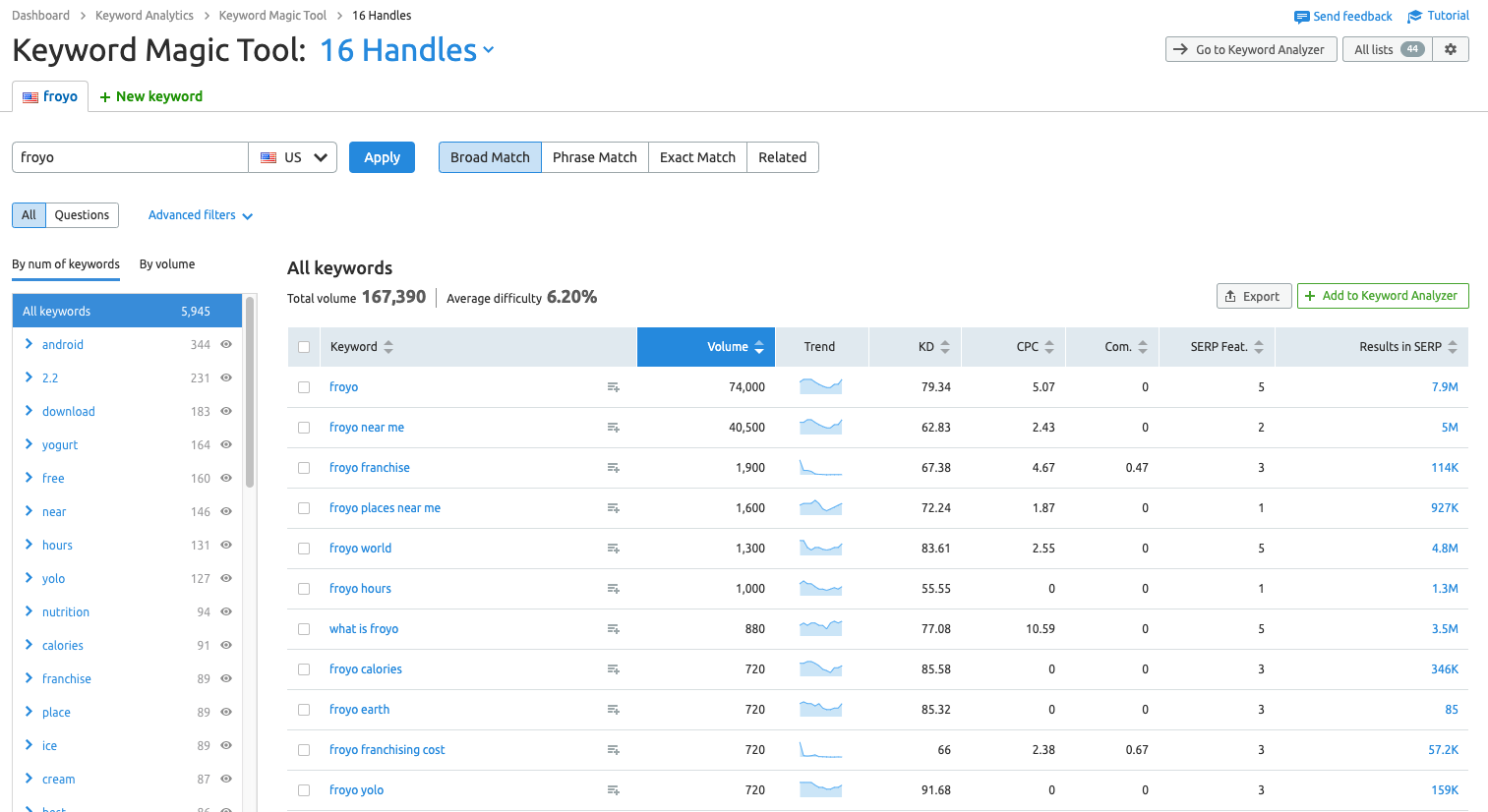
Run a Local SEO Audit
First things first, you need to get the lay of the land. How is your site currently doing with local SEO?
Step 1: Keyword Check
Open up an incognito browser to make sure your previous browsing history will not affect your search results. Then, search what you think are the most obvious and important terms for your business. Are you showing up in the top search results? As you can see in the search results below, 16 Handles shows up first in the local map pack for ‘Boca Raton froyo.’ A pretty important keyword for a business in Boca Raton that sells froyo!
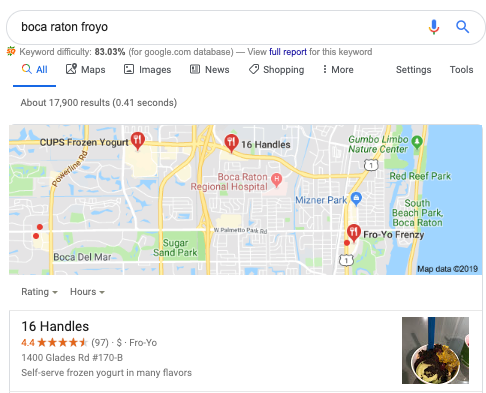
Step 2: Google My Business Search
Next, search to see if your business already has a Google My Business setup. You should see the below in red if your company has one.
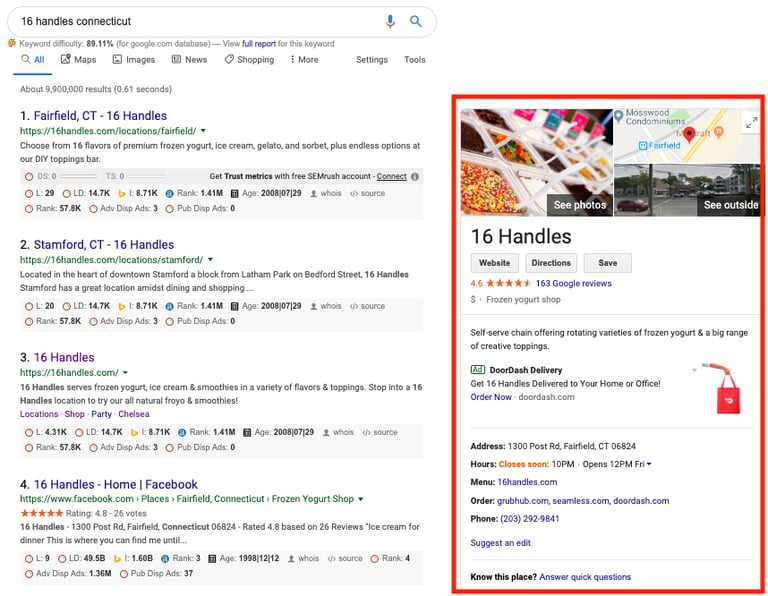
If you don’t see the above in the search results, there are a few possibilities outside of just not having one setup. But if that’s the case, read our guide here to set up a Google My Business.
Step 3: Google My Business Analysis
If you have a Google My Business, is it properly set up? A few questions to ask yourself:
- Is the description user-friendly? Would you click on your site?
- Is it overly stuffed with keywords? You don’t want this.
- Does your primary category accurately reflect your business?
- Is the proper address showing up?
- Are there any reviews? If so, are they good? Are they bad? Have you responded to bad reviews?
- Are address, hour, website, phone number, and all other information properly listed?
- Any photos?
If you said yes to all of the above--except for #2 because we don’t want to keyword stuff--then your GMB is good to go.
Step 4: Website
Next up is on-site optimization, the process of making your site as search engine friendly as possible for the proper keywords. A few questions to ask yourself:
- Does the homepage title include location, brand, and keywords?
- How is the home page content? Is it user-friendly or keyword-stuffed?
- Is your NAP (Name, Address, Phone Number) located in the footer or header?
- Is it properly marked up with schema? Use Google’s Structured Data Testing Tool.
- Are there specific content pages about your services and products? Same as
- What are the title tags on the rest of the site? Do they include proper keywords?
- Does the internal link structure make sense? Is it easy to find all relevant information?
- Is there a contact page? Is there a map embedded properly on it?
- Is there a blog? Is it active? How many posts?
- What are all of the various components that go into your website? Use the BuiltWith Chrome extension to find out.
- Just based on the eye appeal, how does the site design look?
- Are social networks listed in the footer, and do they link to the right pages?
You can also use SEMrush’s Site Audit to streamline a lot of the above. But as with any technology, some things are missing, so it’s always recommended to do it manually at least the first time.
Step 5: Social Media
Is your business correctly represented on the preeminent social media channels? Which channels are necessary is dependent on your business, but it doesn’t hurt to have all of them: Instagram, Facebook, Twitter, Pinterest, Snapchat. You should even have a Youtube if you want to up your SEO game :)
Step 6: Backlink Audit
Everyone’s favorite step of a local SEO audit! Just kidding, this one is awful. Thankfully, if you have a project set up in SEMrush, you can conduct a Backlink Audit. The audit will automatically compile your backlinks, the total backlink count, the number of root domains linking to your site, the anchor text, and any toxic backlinks that need to be disavowed with Google.
Step 7: Local Citation Audit
Use the SEMrush Listing Management tool to identify where your local business information is showing up correctly, improperly, or not at all. I get more into this below.
Step 8: Rejoice
Have a drink. You’ve completed your first local SEO audit!
HA, not so fast. It’s time to take control of your online presence.
Take Control of Online Presence
So you already have information on your website about your business--facts like address and phone number. Is this information showing up correctly and consistently across the many search engines, apps, maps, social networks, voice assistants, directors, and more that consumers use to search?
Digital Knowledge
First and foremost, your digital knowledge is your NAP data, along with information like hours of operation, if you have outdoor seating, and whether or not you allow pets. Your Nap Data includes location-specific information like:
- Name
- Address
- Phone number
Your NAP data and your more specific information should appear on your website and Google my Business (GMB), Facebook, Yelp, TripAdvisor, Apple Maps, Yahoo, Bing, and the hundreds of other local directories.
Why Should You Care About Digital Knowledge?
When your business facts appear consistently across a variety of sources, search engines trust the information more. In turn, higher trust from the search engines will lead to your site showcasing sooner than others in local search rankings.
How Can I Manage My Digital Knowledge?
Listing Management, a SEMrush tool made in collaboration with Yext, allows you to correctly distribute your business data to over 50+ authoritative search directories.
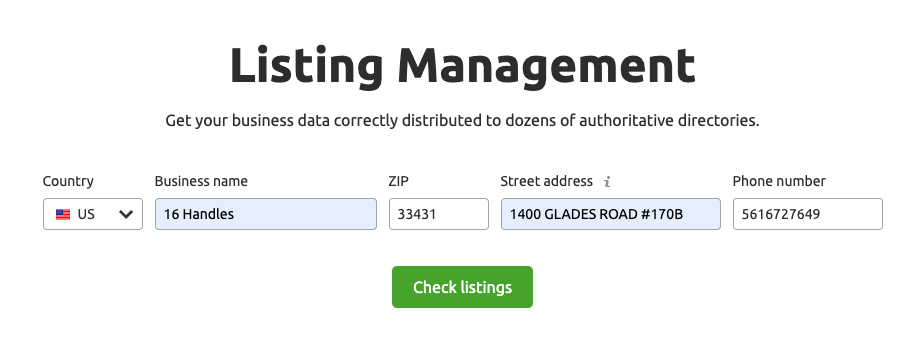
Click Check Listings, and you will see all of your listings as well as the status of each.
You can see the number of directors with the proper listing, those with issues, and those that don’t have your information. Simply click distribute info for the Listing Management Tool to blast out your proper information.
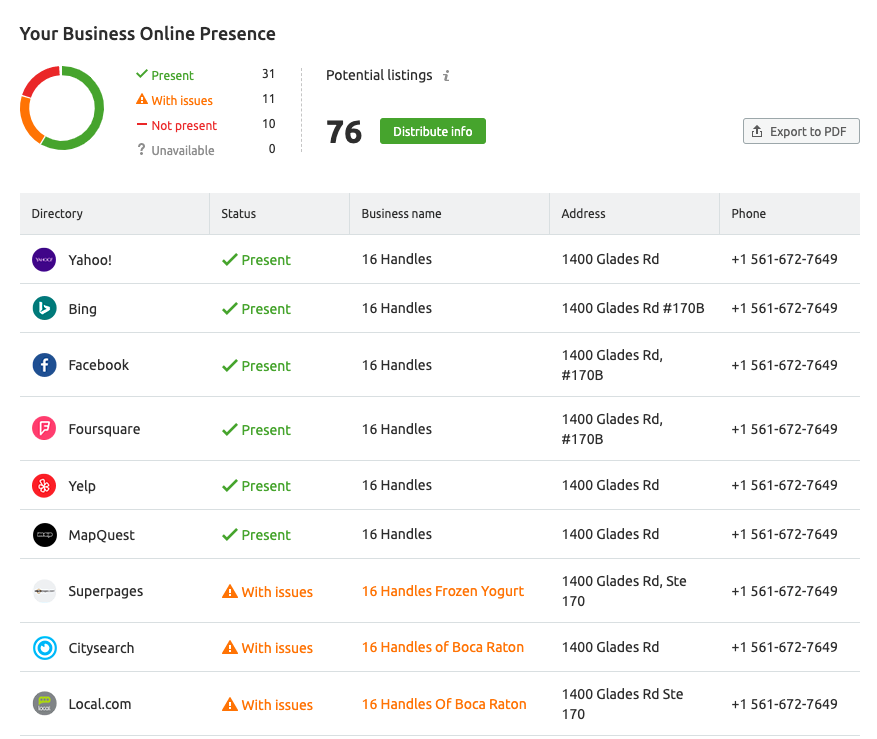
Google My Business & Bing Places
As a local business, it is paramount that you have a Google My Business & Bing Places page.
Optimize Your Website
How many times have you heard this but weren’t told what it means? Well, first things first, your mobile experience is essential when you’re a local business. Many people search for local businesses on the go (60+%), so you need to have an excellent mobile experience.
It’s even more critical considering Google now indexes your site mobile-first.
Incorporate nice pictures into your site (but make sure these are compressed to optimal file size, <65kb, so they don’t mess up your site speed) and include short descriptions with a clean look.
Follow Google’s guidelines for creating a mobile-friendly website.
SEMrush Optimization
No matter what your business is or where it’s located, you should set up the Site Audit tool to check on your website’s health. It will show you where there are broken links on your website, amongst other red flags.
Navigate to your Project and click on Site Audit. Enter the maximum number of pages you want the crawler to audit and from what source.
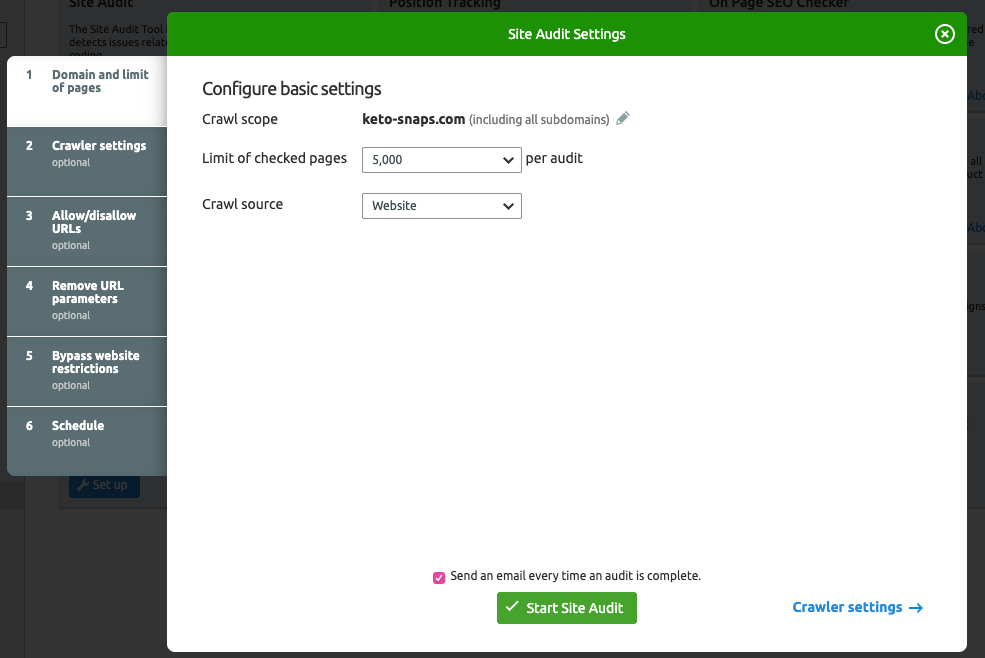
Next, you’ll choose what user agent you want to use. I always select GoogleBot-Mobile.
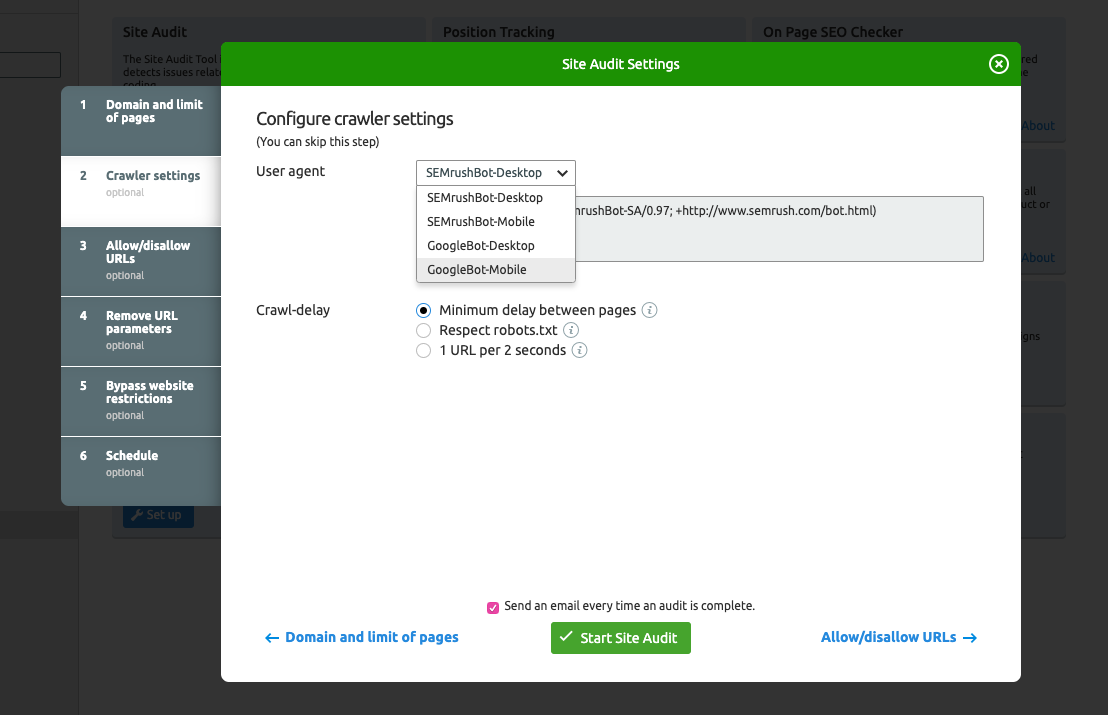
This way, the crawler goes for a mobile version of the site and uses Google to do so instead of SEMrush’s native crawler. Google is, after all, the one determining where you show up in the search results.

Take a look at your site’s total score and assess how much work there is.
Next, look at your Thematic Scores to identify your top areas of issues:


- Crawlability: Are all of your essential pages accessible to the search engines so that they can be indexed?
- Performance: Page loading speed. This is a big one, especially for local businesses where many searchers will be using mobile. More than 50% of mobile users will leave a site if it takes 3 seconds or longer to load.
- Internal Linking: Users should get the information they are looking for and need in as few clicks as possible. Structuring your website properly also allows for evenly distributed link juice.
- HTTPS: How secure is your site?
- International SEO: In the screenshot, our client doesn’t have multilingual websites, so hreflang implementation is not needed.
Website Visibility
When you’re a local business, the search query “X near me” is going to be incredibly important for driving search traffic to your physical location. You must have a grasp of what you want your site to rank for and what it currently is ranking for.
A few keyword research tools include:
A few software tools to track keyword rankings:
Even if you rank well in the desktop search results, it doesn’t mean that you will be seen in the mobile search results because of the ads and SERP features taking up the limited screen space.
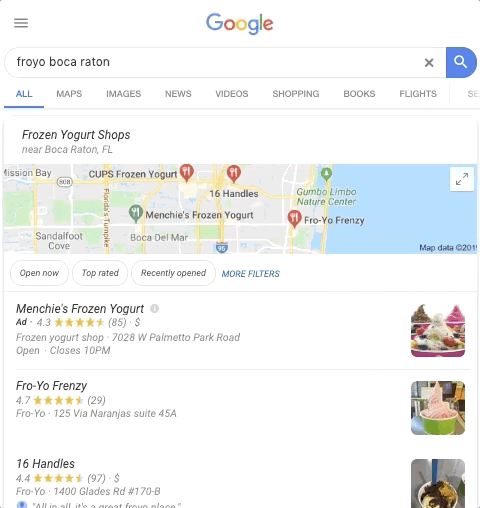
Above is an example of the mobile SERP for the request “froyo Boca Raton.” First, there is a map with four local listings, with the first being an ad for Menchie’s Frozen Yogurt (there map listing is in green instead of red). Our client, 16 Handles, shows up 3rd in the local map pack. Then, following the map pack, there are the organic search results.
As you can see, the best way to gain more visibility for your site and your business is to get into the Local Pack results.
Getting Into the Local Pack
Aside from managing your digital knowledge, keeping your NAP consistent across all local directories, and doing on-page keyword optimization, there are a few more things you can try to increase your changes:
- Reviews: Reviews are the holy grail for local businesses. I mean, when’s the last time you went anywhere without looking it up on Google or Yelp first? Drive your customers to leave reviews for your business, and make sure to stay proactive with any negative ones that may pop up!
- Backlinks: Just like with any website, backlinks will help increase your site’s ability to rank. Reach out to local websites that write local news, cover local businesses, host local blogs, offer guest posts, or ask for a feature.
- Custom Markers: Stand out from the rest of the map results by creating a custom marker. More here.
- Google My Business Posts: Create high-quality local content!
Keyword Research
Start your search for keywords with the keyword magic tool from SEMrush. Here you can enter one seed keyword to generate hundreds and thousands of total keyword possibilities. I mean, the database is pulling from a bank of 10.6 billion keywords!
Start your search by entering a target keyword and click Search. For this example, we chose the keyword froyo.

Now, we get a table populated with keywords that are a “broad match” to the keyword “froyo.” Whichever keyword you use, the software will do the same.
But what is a broad match keyword? Well, there are four different keyword types you can search for in the keyword magic tool:
- Broad Match: Any variation of your seed keyword or keyword phrase in any order (froyo near me, froyo franchise, froyo calories, what is froyo)
- Phrase Match: Exact keyword or keyword phrase in any order.
- Exact Match: Exact keyword or keyword phrase in exact order.
- Related: A list of keywords that are similar to your keyword
When you come across a keyword that you like, click the plus arrow next to the keyword to add it to your keyword analyzer. Once you are done searching for new keywords and have compiled a good amount, click on Go to Keyword Analyzer in the top right corner to go to your keyword analyzer.
To hide groups that are not relevant to what you are searching for, click the ‘eye’ icon next to the group.
Once here, click Update metrics to fill in the data for your selected keywords. Then, you can start narrowing down your list until you have a few that work best.

Keyword Filters
To further define your search, you can play around with filters in the keyword magic tool to exclude specific keywords and specify a range for search volume, word count, difficulty to rank (KD%), cost-per-click (CPC), and also select SERP features. This will help you find long-tail keywords, which can be more valuable to your business because they carry greater user intent (specific search queries have a higher conversion rate generally).
On-Page SEO
Title Keywords
On your pages, your keywords should descend according to their search volume, so when you are doing your keyword magic tool research, it’s a good idea to sort by volume. The keyword volume should descend in this order:
- Title: keywords with the highest volume
- Under 70 characters and between 8-12 words
- Actionable (tell the reader the answer you are going to give them)
- Search optimized and reader optimized.
- Headings: keywords with average volume
- H1: Most important topic
- H2: Subsections of your page (I like to create new tabs in the keyword magic tool for each H2)
- Paragraphs: keywords with lower volume
- Avoid keyword stuffing. You want the page to be properly optimized for search engines but also appealing to the reader.
One other thing to note is your page’s meta description. This is what shows up on Google’s SERP and will impact the CTR for your page.
Tracking Results
It’s not enough to do all of the above and just let it be. How are you supposed to know whether what you did is working or not? Aside from that, your competition is hard at work as well. It’s critical to stay up to date with your SEO and to continue to push the envelope.
In comes SEMRUSH’s position tracking tool. This tool tracks your site’s rankings for a custom set of keywords. You can manually add these keywords, pull them from Google, or allow SEMrush to fill them in.
Domain Settings
When you are setting up position tracking for your site, you can choose from four options:
- Tracking root domain: This option tracks the entire root domain, including any subdomains as well. (e.g., 16handles.com, shop.16handles.com, 16handles.com/boca-raton)
- Tracking subdomain: Tracks a specified subdomain (e.g., www.16handles.com, shop.16handles.com)
- Tracking URL: Tracks a specific URL (e.g., 16handles.com/boca-raton)
- Tracking subfolder: Track a specific subfolder (e.g., www.16handles.com/boca-raton) that will track up to 3 subsequent folders as well (e.g., www.16handles.com/boca-raton/hours)
Once you have selected your domain settings, enter your business name as it appears in the local map pack. WARNING: THIS MUST BE EXACT. For example, 16 handles would not work here because it shows up as 16 Handles (with that capital H) in the search results.
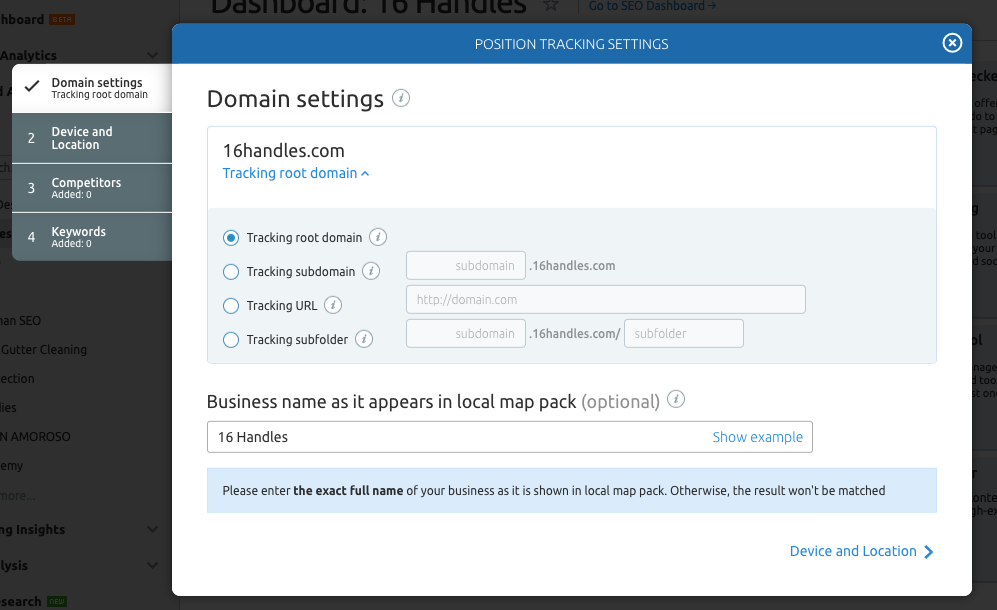
This is important because Google won’t always add website links to the local map packs, especially when searching on mobile SERPs. So, in this case, it would be significantly harder to track your rankings. By inserting your company’s exact name as it appears in GMB, you will be able to see if you appear in the local packs.
Device and Location
Choose which device and location you want to track. You can even target by zip code, allowing you to get hyper-specific. With SEMrush, you can go deeper than just the city level.
Local search results are all about proximity, so monitoring your exact location’s performance is extremely beneficial. There’s no point in focusing on nationwide queries if you have one local shop.
Our client, 16 Handles, has over 30 locations throughout the US, so we have to use Multitargeting. Instead of accumulating separate data in various projects, we can view and track different local keywords and rankings in the same campaign for all 16 Handles locations. For example, one of their New York locations will have significantly different keywords than their Boca Raton location.
Once you select your zip code or location, you are given the option to choose between national search volume and local search volume. Since we are setting this up for the Boca Raton location, we select local volume because we are interested in the local search volumes.
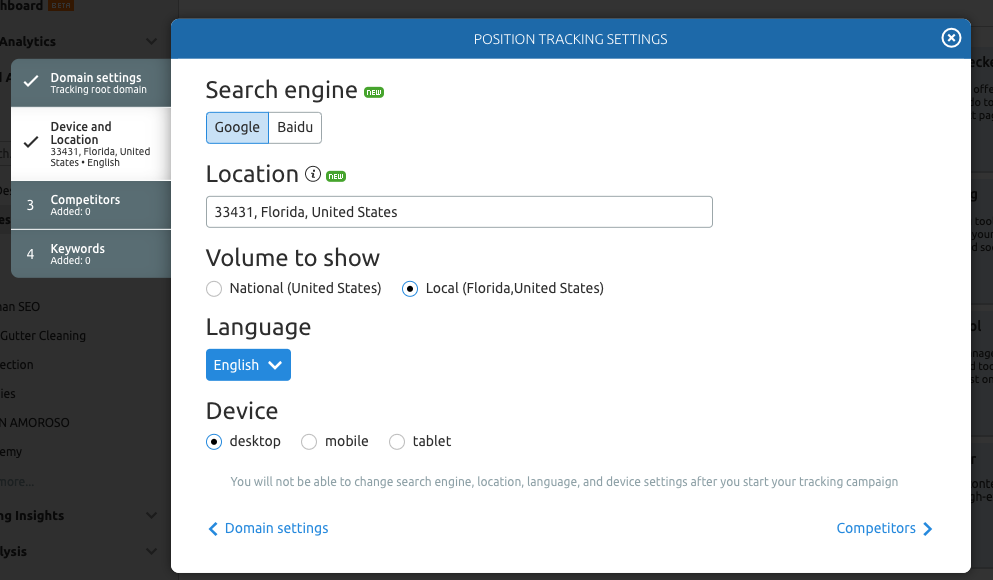
We have desktop selected for Device in the screenshot, but you can change this to whatever you please. We already have a mobile setup for 16 Handles, so we have desktop selected, but if you have to choose between one or the other, select mobile. As mentioned before, Google utilizes mobile-first indexing, and a majority of local searches happen on mobile.
Competitors + Keywords
To finish setup, you have to select competitors. You can add competitor URLs that you know of, utilize the suggested competitors generated by SEMrush based on mutually shared keywords, or use AdWords (only if you have an AdWords account connected).
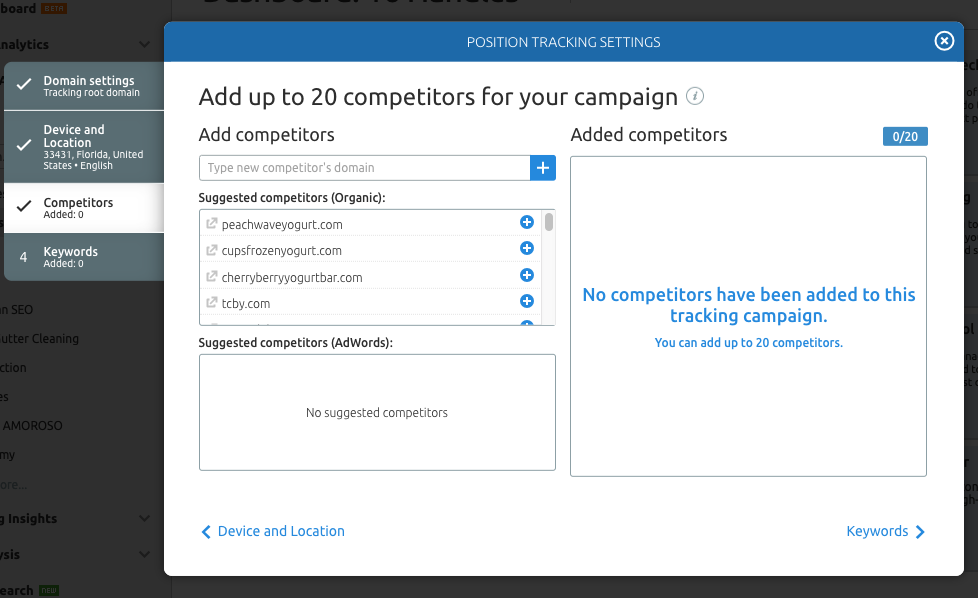
Once you select your competitors, you now have to choose your keywords. You have four different options to add keywords:
- Manually: Self-explanatory. Type in keywords.
- SEMrush: SEMrush will pull keywords you are ranking for in the organic search results, or you can select a URL of a competitor inputted in the last step to pull keywords they are ranking for.
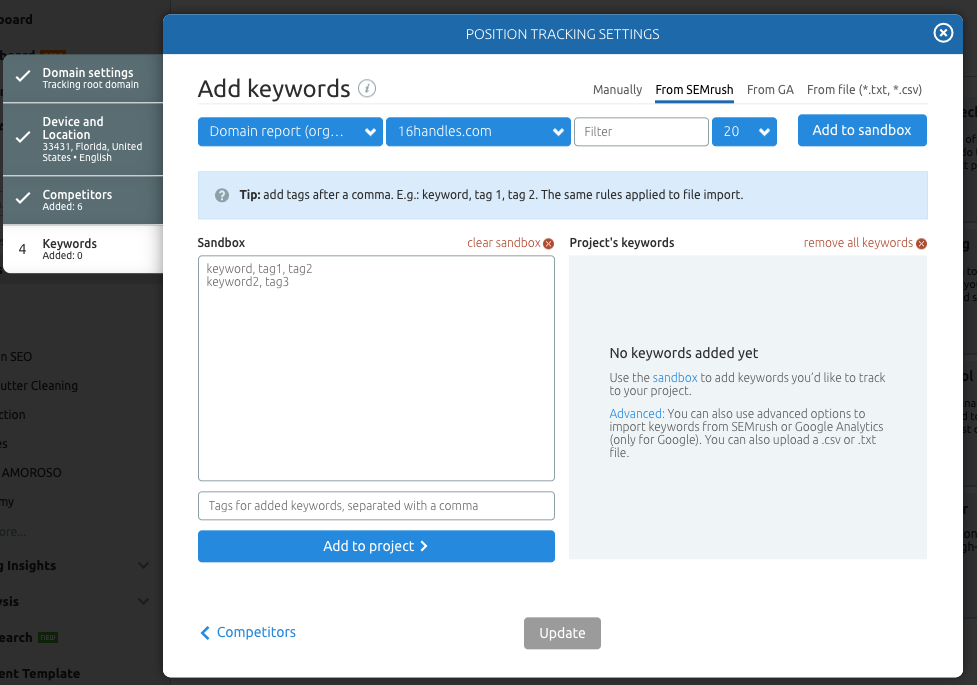
- GA: You can connect your Google Analytics account to pull keywords from GA. This one can be a bit finicky, but it is a great source to use if it is working.
- From file (*.txt, *.csv): If you have your keyword list in an excel file, you can upload it this way.
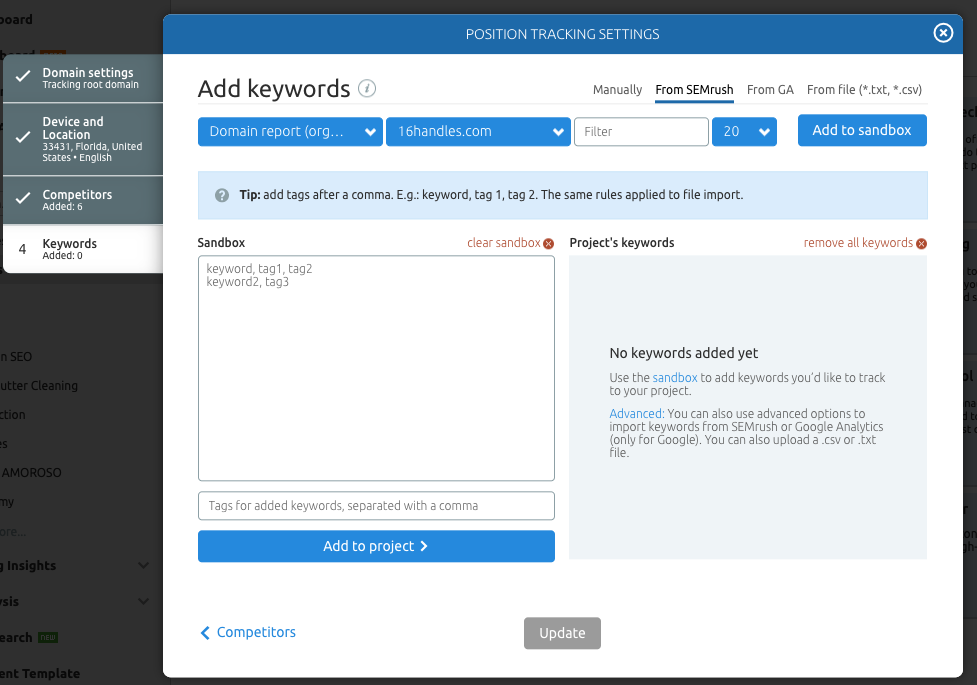
I prefer to use the keywords that are generated by SEMrush or from Google Analytics.
Now you’re ready to start tracking! Just click Update and let SEMrush gather the data.
Once the keywords are loaded, you can navigate to the Competitors Discovery tab to see your closest rivals. Something I’ve noticed is sites like Yelp and Facebook will show up here. Since they aren’t relevant, I will blacklist them because they are not in direct competition with me (you should do the same for local businesses that aren’t in direct competition with you). For the URLs you find that ARE competitors, you should click Set as competitor next to their domain.

One of my favorite tools in Position Tracking for local businesses is the ability to filter by SERP features.
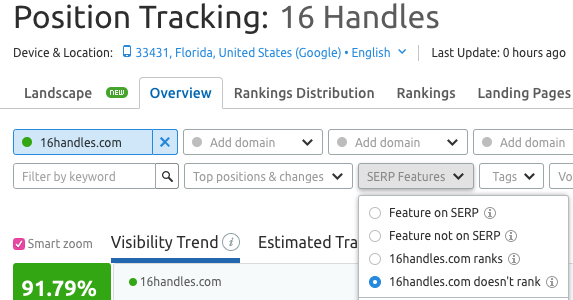
If you navigate back to the Overview tab and click on SERP Features, you will be able to filter your keywords based on a variety of various factors. The easiest one to use is “URL doesn’t rank.” Now, you will have a list of keywords you need to work on!
You are also able to filter for results that have reviews. Having a rating on your search result snippets can dramatically impact your ranking and click-through rate (CTR). To acquire these, you will need to add a special markup on your website’s pages.

Reporting
No job would be complete without actually having to show your results! Like anything, taking the proper approach and disseminating the data appropriately will ensure that no one gets overly confused by all these numbers!
We use the SEMrush My Reports tool to streamline our reporting process and make sure our clients can visualize and understand the impact we make.
Google My Business
I won’t go entirely into reporting here, but for local SEOs, Google, My Business is essential. Simply navigate to the Google My Business dropdown in the Report Builder, and you will see the five options available to you.
For each report, make sure to set the time frame you want to view. Our three favorite Google My Business Reporting options are:
- Overview: Includes the number of times a customer viewed your site, the number of times a customer requested directions, the number of calls, and the number of photo views
- Customer Actions: Line graph of website visitors, callers, and direction requests
- Calls: The number of calls by day of the week to your business.

